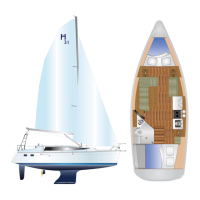ENVIRONMENTAL CONSIDERATIONS
PAGE
21
FUEL AND OIL SPILLAGE
The spilling of fuel or oil into our water-
ways contaminates the environment and
is dangerous to wildlife. Never discharge
or dispose of fuel or oil into the water. It
is dangerous and unlawful. Two com-
mon types of accidental discharge are
overfilling the fuel tank and pumping
contaminated bilge water into the sea.
EXPLOSION/FIRE/POLLUTION HAZ-
ARD:
Fill fuel tank to less than rated capacity.
Overfill forces fuel out the tank vents,
which can cause explosion fire, or envi-
ronmental pollution. Also allow for fuel
expansion
DISCHARGE AND DISPOSAL OF WASTE
Waste means all forms of garbage, plas-
tics, recyclables, food wood, detergents,
sewage, and even fish parts in certain
waters. We recommend that you bring
back everything you take out with you
for proper disposal ashore.
Your marine holding tank (if so
equipped) must, in many areas, be
pumped out by an approved pump-out
facility normally found at marinas.
EXHAUST EMISSIONS
Hydrocarbon exhaust emissions pollute
our water and air. Keep your engine
properly tuned to reduce emissions and
improve performance and economy.
ANTI-FOULING PAINTS
The use of anti-fouling paints is
common for boats kept in water. Be
aware of environmental regulations
that may govern your paint choice.
These regulations may affect which
paint may be used, and also the ap-
plication or removal. Contact your lo-
cal boating authorities for more in-
formation
EXPLOSION/FIRE/HAZARD:
Ventilate when painting or cleaning.
Ingredients may be flammable and/or
explosive.
CLEANING CHEMICALS
Cleaning chemicals should be used
sparingly and not discharged into
waterways. Never mix cleaners and
be sure to use plenty of ventilation in
enclosed areas. Do not use products
that contain phosphates, chlorine,
solvents, non-biodegradable or pe-
troleum-based products.
Common households cleaning
agents may cause hazardous reac-
tions. Fumes can last for hours, and
chemical ingredients can attack peo-
ple, property and the environment.

